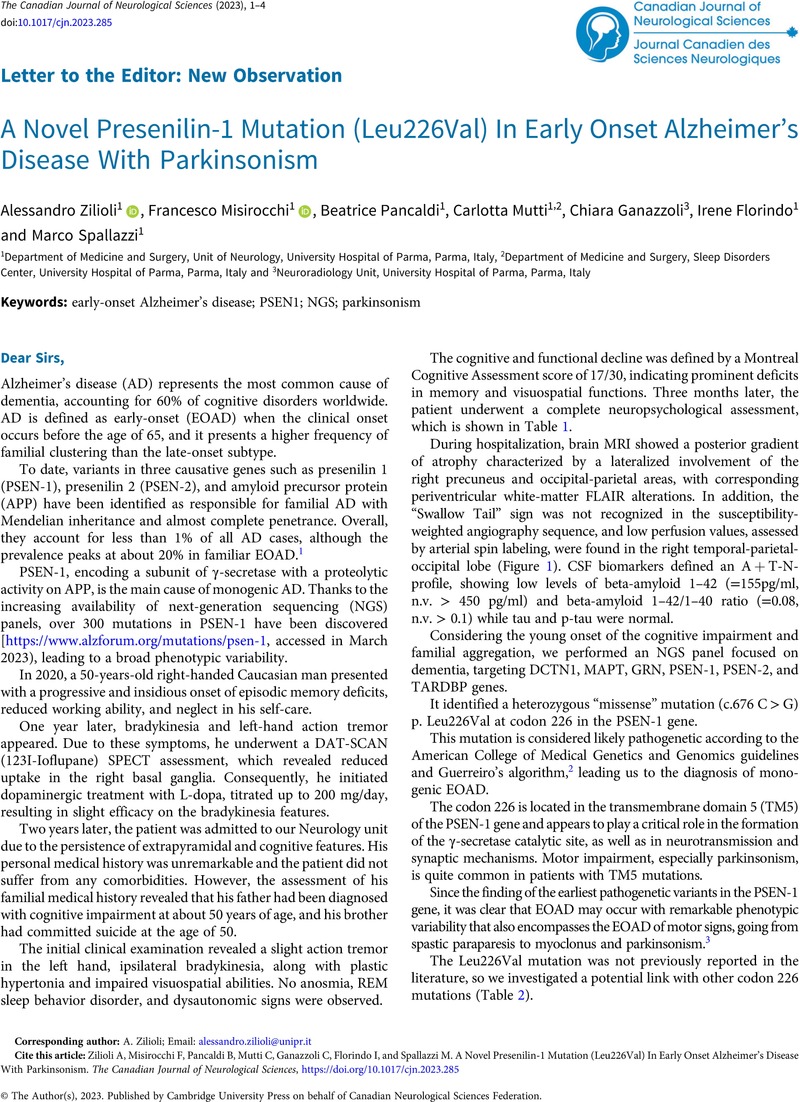No CrossRef data available.
Article contents
A Novel Presenilin-1 Mutation (Leu226Val) In Early Onset Alzheimer’s Disease With Parkinsonism
Published online by Cambridge University Press: 11 September 2023
Abstract
An abstract is not available for this content so a preview has been provided. Please use the Get access link above for information on how to access this content.

- Type
- Letter to the Editor: New Observation
- Information
- Copyright
- © The Author(s), 2023. Published by Cambridge University Press on behalf of Canadian Neurological Sciences Federation
References
Bartoletti-Stella, A, Tarozzi, M, Mengozzi, G, et al. Dementia-related genetic variants in an Italian population of early-onset Alzheimer’s disease. Front Aging Neurosci. 2022;14:969817. DOI: 10.3389/fnagi.2022.969817.CrossRefGoogle Scholar
Guerreiro, RJ, Baquero, M, Blesa, R, et al. Genetic screening of Alzheimer’s disease genes in Iberian and African samples yields novel mutations in presenilins and APP. Neurobiol Aging. 2010; 31:725–31. DOI: 10.1016/j.neurobiolaging.2008.06.012.CrossRefGoogle ScholarPubMed
Ryan, NS, Nicholas, JM, Weston, PSJ, et al. Clinical phenotype and genetic associations in autosomal dominant familial Alzheimer’s disease: a case series. Lancet Neurol. 2016;15:1326–35. DOI: 10.1016/S1474-4422(16)30193-4.CrossRefGoogle ScholarPubMed
Takao, M, Ghetti, B, Hayakawa, I, et al. A novel mutation (G217D) in the Presenilin 1 gene (PSEN1) in a Japanese family: presenile dementia and parkinsonism are associated with cotton wool plaques in the cortex and striatum. Acta Neuropathol. 2002;104:155–70. DOI: 10.1007/s00401-002-0536-6.CrossRefGoogle Scholar
Xie, L, Shinohara, RT, Ittyerah, R, et al. Automated multi-atlas segmentation of hippocampal and extrahippocampal subregions in Alzheimer’s disease at 3T and 7T: what atlas composition works best? J. Alzheimers Dis. 2018;63:217–25. DOI: 10.3233/JAD-170932.CrossRefGoogle ScholarPubMed
Coleman, P, Kurlan, R, Crook, R, Werner, J, Hardy, J. A new presenilin Alzheimer’s disease case confirms the helical alignment of pathogenic mutations in transmembrane domain 5. Neurosci Lett. 2004;364:139–40. DOI: 10.1016/j.neulet.2004.04.030.CrossRefGoogle ScholarPubMed
Bartesaghi, F, Rosci, CE, Rassiga, C, et al. Psychiatric disorders in Alzheimer disease with the presenilin-1 L226F mutation. Cogn Behav Neurol. 2020;33:278–82. DOI: 10.1097/WNN.0000000000000249.CrossRefGoogle ScholarPubMed
Jiao, B, Liu, H, Guo, L, et al. The role of genetics in neurodegenerative dementia: a large cohort study in South China. NPJ. Genom Med. 2021;6:69. DOI: 10.1038/s41525-021-00235-3.Google Scholar


